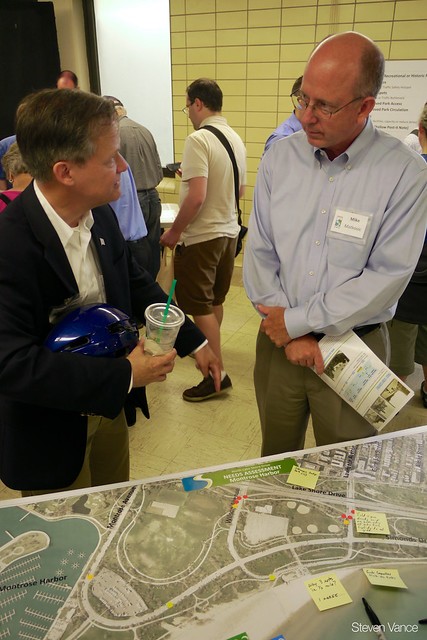There is no highway for the sake of traffic. There is a highway for the sake of moving large quantities of people because people generate traffic. Depending on the highway's alignment, and the land use, how much traffic people will choose to generate is highly influenceable. If it's tolled, more people than usual will carpool or take transit. If a highway is built passing highly desirable destinations without other ways to reach them, it will get congested. Neither of these are uncontrollable phenomena. I'm talking about Lake Shore Drive and the project to study the alternatives for the corridor between Grand Avenue and where Lake Shore Drive ends at Hollywood Avenue. The study's public participation, the first group in a series of 5 meetings, began last week, where citizens learned about the study and the data project group members – the Chicago and Illinois Departments of Transportation, CTA, and the Chicago Park District – have gathered so far.
The Chicago Sun-Times editorial board published on Friday an article that expresses their desire to perpetuate the status quo of highway building, income lessening, transit disinvestment, and air quality reduction. Sun-Times editorial writers also don't understand that the scope of the project, being undertaken by the Chicago and Illinois Departments of Transportation, includes more than just roads and paths.
The article sets the tone in the first paragraph: "any final plan for a rebuilt Drive must begin with this simple reality: It's [sic] primary job is to move traffic."
This city, if it is to become a growing city once again, needs it to do much more than that. As we take part in the process to redesign North Lake Shore Drive – comprising the multi-use and multi-mode corridor of parks, roads, and paths – we must agree that the best change to the lakefront would be to increase access and mobility for the greatest amounts of people with respect to safety, environment, and costs.
Let's break down the flaws in the Chicago Sun-Times's position for you step by step:
- "Incorporating a rapid-transit line [in the 1930s] would have been foresighted." We're not stuck with LSD the way it is. We can be foresighted ourselves and we can change it. And look at this, buses can form a rapid transit line on highways!
- "More space for bike and pedestrian paths would have been ideal." The original builders created space for the Drive by filling in the lake with landfill. This isn't an extraordinary task.
- "And it’s nothing short of amazing how charming and active our lakefront is in spite of the multi-laned barrier we have erected along the shoreline." So Sun-Times editorial writers agree that the highway forms a barrier. Do they also know that three intersections with the Lakefront Trail make up three of the top 20 bike crash locations?
Despite its thesis – that Lake Shore Drive's "primary job is to move traffic" – the article recognizes, apparently without the writers realizing it, that the corridor serves different purposes for different people.
Many of the 22 pedestrian underpasses need a significant overhaul. In rush hour, traffic on exit ramps backs up onto the Drive, creating hazards. In many places, getting across the Drive for a bike ride or walk along the lake can be intimidating. Often, people who live or work near the lake just don’t bother.
The editorial supports many of the "Our Lakefront" proposals but fails to recognize that traffic doesn't exist to take up space. It appears because people want to go places. The editorial board says, "What we can’t do is draw up bucolic-looking renderings that fail to make room for all the cars the Drive accommodates now. Where is that traffic supposed to go?"
It will go to where we support it going. Some people have more choices than others in what mode they take, when they can go, and at what cost they travel. And not accommodating or supporting a variety of choices continues to limit people's options in where they live and work, and how well they live. Not every can afford a car, and some choose to forgo car ownership for any number reasons.
One can't be sure from this editorial if the authors know that 27% of the people in traffic on NLSD are actually traveling in transit buses. But how well do they move? As slow as those driving alone, for sure, but for every additional car with just a driver, the bus, carrying 60 times as many people, goes a little bit slower.
The editorial board purports to be interested in building transit to reduce the demand for drivers on highways by saying "making room for a rapid-transit line on the drive, which would reduce the need for driving" but qualifies its endorsement with "we need extensive documentation that it would lure a large number of people out of their cars."
We have decades of studies showing that when transit gives people the opportunity to lower their transportation expenses, they choose it. We have studies showing traffic evaporates: that if you don't build those highway lanes, they don't come in their cars.
The Sun-Times editorial board need to recognize that it’s more important, and practical, to move people than cars.






